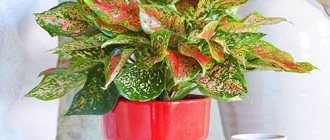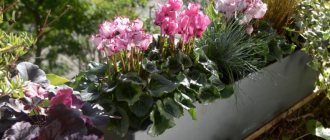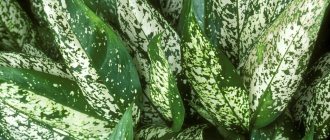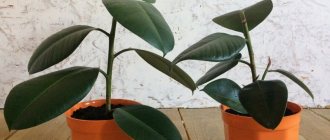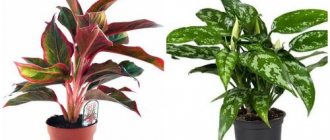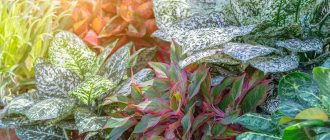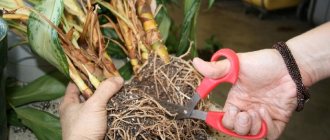Photo of aglaonema Aglaonema (Aglaonema) is an ornamental evergreen plant from the Araceae family. Southeast Asia is considered its homeland. It is found naturally in the Philippines, New Guinea, and India. The height of the bush ranges from 25 to 75 cm. The trunk is not noticeable. The flower attracts attention with its leathery green leaves, which have an oblong shape and pointed ends. They clearly show a central light stripe and small patterns in the form of spots and stripes.
Aglaonema grows slowly; the foliage is replenished with 5–6 leaves per year. It blooms rarely, producing an inflorescence - an ear, wrapped in a pale blanket. At home it lives up to 3 years, then it loses its decorative properties and needs updating.
| Growth up to 6 leaves per year. |
| It blooms very rarely. In autumn. |
| The plant is easy to grow. |
| Perennial. But after 3-4 years the leaves are no longer so variegated. It is better to grow a new plant every 3-4 years. |
Beneficial features
It humidifies the air in the room. Reduces the level of toxic substances released by new furniture and gas stoves. Some species disinfect the air, clearing it of anaerobic bacteria. During a period of intensive growth, a flower releases air ions that cause a charge of vigor and increase resistance to stress.
Growing conditions
Aglaonema Maria is a perennial, slow-growing plant. The flower is undemanding to bright light, so it grows and develops well in rooms with a moderate amount of light.
The main requirements for growing are constant high humidity and warmth. Eliminate the possibility of drafts and sudden temperature changes. In the summer months, the temperature should be maintained around +25°C, in winter - not lower than +15°C.
Humidity is maintained by regular spraying; in winter it is dormant, so the quantity and frequency of spraying should be reduced. Leaves must be wiped with a clean, damp cloth to avoid dust accumulation. The soil in the flowerpot should always remain moist.
Features of growing at home. Briefly
Despite its tropical origin, aglaonema grows well at home if you follow the basic rules for growing it:
| Temperature | In winter, without watering, it can withstand up to + 10 -15°C, in summer + 24°C. |
| Air humidity | Increased; Spray frequently in summer, less often in winter, but keep the flower pot in a tray with moistened expanded clay. |
| Lighting | Scattered; slight shading. |
| Watering | Settled lukewarm water; In summer the soil should be moist, in winter it should be watered rarely, about once every 10 days. |
| Priming | Air-permeable, loose, moisture-retaining - ready-made soil for bulbous plants or prepared yourself from garden soil, peat, perlite (1: 2: 1), for young bushes - from leaf soil, turf soil, perlite, peat (2: 1: 1: 1. |
| Feeding and fertilizer | Once every 14 days, alternating mineral fertilizers and organic matter in liquid form. |
| Transfer | A week after purchase, transfer it to a small low pot with a drainage hole; Young bushes are replanted every spring, adult plants - once every 4 years. |
The plant is unpretentious and easy to care for, but there are some peculiarities in growing aglaonema. All parts of the flower contain toxic substances, oxalic acid, which cause skin burns and irritation of mucous membranes. The juice and berries that appear after the plant blooms cause severe allergies. Therefore, you need to work with the plant very carefully, wearing gloves. Make sure that children and animals do not touch the bush.
Possible problems
When grown in improper conditions, aphids, scale insects and thrips may appear on the plant . When kept dry and low humidity, plants are attacked by spider mites . In addition, the possibility of rotting of the root system or yellowing of the foliage cannot be ruled out.
For preventative purposes, it is necessary to regularly inspect potted plants in order to see the problem in time and eliminate it.
If plants become sick with leaf spot or gray rot, then the diseases must be combated with the use of fungicides.
Aglaonema is a useful indoor plant. Its foliage absorbs harmful substances, in particular benzene. Due to its undemanding requirements for lighting, the plant is used to decorate rooms of varying lighting conditions.
Watch a video about the intricacies of caring for it:
Caring for aglaonema at home. Details
The aglaonema flower develops correctly in indoor conditions and feels good if its needs for light, warmth, nutrition and moisture are met.
Landing
The high decorative properties of the plant largely depend on proper planting.
The quality of planting material (cuttings, seeds, fragment of a bush) is important. If you choose the seed planting option, use only fresh seeds collected from ripe scarlet berries. Planting is carried out in spring and summer. A fertile, loose, breathable acidic substrate will provide the plant with good nutrition and improve its appearance. Planting aglaonema involves choosing the right place. The flower feels comfortable on a window facing any side except the south: bright sunlight can cause burns to the foliage.
Bloom
Aglaonema rarely blooms at home.
The beauty of the plant lies in its variegated emerald leaves. Aglaonema flowering is an unattractive phenomenon. From February to November, inconspicuous inflorescences in the form of greenish-yellow cobs, wrapped in a pale blanket, form in the axils of the upper leaves. There can be 1 - 3 pieces. Depending on the variety, the cobs look like a thick short club or a thin long cylinder. Sometimes gardeners sacrifice inflorescences and cut them off for the sake of new leaves. If you don’t do this, you can wait for the fruits to appear - scarlet (less often white) berries with a single grain inside.
Temperature
To preserve the decorative appearance of the flower, it is important to strictly observe the temperature regime. Aglaonema is a heat-loving plant. Drafts and sudden changes in temperature can destroy it. Although there are varieties that can withstand cold temperatures down to + 10°C, the optimal temperature for a flower is considered to be between 15 – 25°C in summer and 15 – 18°C in winter.
If you do not water in winter, the plant can tolerate lower temperatures.
Spraying
The tropics are characterized by high air humidity. To make indoor aglaonema feel comfortable, you need to spray the plant twice every 14 days in the summer, take a warm shower, or wipe the leaves with a damp cloth more often. Just don’t allow moisture to accumulate in the rosette of leaves: this can lead to the death of the plant.
In winter, spraying is carried out less frequently, but the flower is placed in a tray with moistened expanded clay or pebbles . During the heating season, the flower is kept away from radiators, air humidifiers are used, or an open container of water is placed nearby.
Lighting
Lighting is important for plant growth. Aglaonema is genetically configured to receive a lot of light, but it should not be bright and scorching, but diffused.
The scorching summer sun can burn the flower, so windows facing south are dangerous for it. It is best to place green-leaved bushes in partial shade. Variegated types of aglaonema, on the contrary, love bright sunlight: under its influence the leaves become more beautiful. But a little shading is also beneficial for these species. In winter, additional lighting is installed for them.
Watering
The plant is moisture-loving, but stagnation of water is detrimental to it. Watering of aglaonema is carried out in spring and summer, when the top layer of soil dries out.
In winter and when aglaonema is kept in a cool room, this is done less often - about once every 10 days. For irrigation, take clean water, settled in the room.
Pot size
There are no small details in the maintenance of the plant. For proper development, even the size of the pot in which the flower is planted is important. A low pot of small volume is preferable. The tightness will stimulate the formation of new leaves and strengthen the root system of the bush.
Priming
Breathable, moisture-retaining soil for aglaonema is very important. The flower grows well in acidic, loose soil. These characteristics correspond to the ready-made soil mixture for bulbous plants. You can make the soil yourself by taking garden soil, peat, perlite (1: 2: 1), and put 2 times more leafy soil for young bushes.
You can add charcoal to the mixture. For mature plants, the amount of turf soil can be increased.
Feeding and fertilizer
Feeding and fertilizing with mineral and organic substances is an important component of flower care.
Aglaonema is fertilized once every 2 weeks with liquid formulations for decorative foliage plants, containing not only the main elements, potassium, phosphorus and nitrogen, but also microelements that prevent alkalization of the soil. To preserve the decorative appearance of the foliage, foliar feeding is carried out: the leaves are sprayed with diluted liquid fertilizer. It is best to do this after watering in cloudy weather, so as not to accidentally burn the plant. All feeding is carried out from the beginning of March to the beginning of October.
You cannot fertilize in winter, because the plant is resting at this time.
Transfer
Aglaonema is transplanted for the first time a week after purchase. When it adapts a little to home conditions, it is transferred from a temporary pot to a permanent container. Young bushes are replanted once a year, adults - once every 4 years. Replanting aglaonema is necessary when the roots completely entwine the earthen ball. It is always produced in the spring.
A new pot is chosen 20 - 30 mm larger than the previous one. It must have drainage holes and a place to pour a thick layer of drainage, which is necessary so that the water in the pot does not stagnate. The soil is carefully selected, taking into account that it loves acidic and loose soil. The soil mixture should include turf soil (an adult bush can put more of it), peat, leaf soil, charcoal and perlite (sand).
Rest period
Like most plants, the dormant period of aglaonema falls in winter . At this time, they reduce the amount of watering and stop stimulating growth with fertilizers and fertilizing.
Trimming
When aglaonema grows, its trunk becomes exposed. This suggests that the flower needs pruning , with the help of which its rejuvenation is carried out. Cut off the top of the plant with a sharp knife, and dust the cut areas with charcoal powder. The stump is left in the pot.
They continue to take care of it and wait for renewal buds to appear. And the top is rooted in water in which activated carbon is pre-dissolved to avoid souring. Sometimes the top is immediately planted in moist soil. Cover with polyethylene and keep at a temperature of +25°C until rooting.
Homemade aglaonema does not require special care; if properly maintained, it will grow healthy and become a real decoration of the interior.
Care
Since the natural growing environment for aglaonema is a tropical climate and high humidity, it is recommended to create similar conditions when growing at home.
Lighting
Aglaonema Maria is not demanding on lighting, so the plant can be used to decorate hallways and offices.
However, you should know that diffused lighting is still necessary for variegated foliage , otherwise the pattern may be lost and the leaf plates may be painted in one color.
In bright sunlight, the leaves get burned and dry out.
Watering
Aglaonema is a moisture-loving plant that prefers high humidity , but does not tolerate stagnant water. The frequency of watering depends on the growing conditions.
If the plant is in a cool room, you need to be careful with watering, as excess water can cause rotting of the root system. Before watering, you need to check the top layer of soil to see how dry it is.
You need to water with settled water at room temperature.
On a note! The leaves of the plant indicate a lack of moisture. If the green mass looks dry and begins to wrinkle slightly, watering is necessary.
Tap water contains a lot of iron or chlorine, which negatively affects the condition of the foliage: unsightly spots appear over the entire surface or the foliage turns yellow.
Transfer
In stores, aglaonemas are sold in a transport pot, which is not at all suitable for further cultivation. After the plant has been in the apartment for several days and adapts to new conditions, it must be transplanted into a suitable pot.
It's better to use transshipment. With this method, the root system will not be injured and the plant will begin to grow faster.
Aglaonema prefers nutritious soil , which you can make yourself. To do this, you will need to take 2 parts of leaf soil, 2 parts of turf soil, 0.5 parts of sand and one part of peat.
It is necessary to make drainage in the pot. As Aglaonema Maria Cristina grows, it needs to be transplanted; for example, adult specimens are recommended to be transplanted into a new pot once every 2 years.
Reproduction of aglaonema
If the flower trunk begins to branch or become bare, the plant is ready to reproduce. Reproduction is possible in different ways.
Reproduction by dividing the bush
The easiest method.
- Take the aglaonema out of the pot and inspect the root system.
- Fragments with a developed root system are separated.
- They are planted in separate containers.
- Water, cover with film and leave at a temperature of + 23°C for several days for the plant to take root.
- It is periodically watered and sprayed.
Propagation of aglaonema by cuttings
Conducted when the trunk is exposed.
- The apical shoot up to 10 cm long is cut off, the cut is sprinkled with coal powder and dried.
- Then they are immersed 5 cm in wet sand.
- Cover with film and keep for a month at + 25°C until the bush gives roots.
- Water and ventilate periodically.
Growing aglaonema from seeds
Perhaps when the aglaonema self-pollinates. The plant produces scarlet fruits. When they ripen on the bush, the seeds must be removed from the berries, washed and planted in a mixture of peat and sand, taken in equal parts. Pour, cover with film and leave at + 25°C. The first shoots appear quickly. When 2–3 leaves appear, the bushes are planted in separate pots. After 3 years you will get strong plants.
All propagation methods are accessible and simple, but it is important to know that when propagated by seeds, aglaonema loses its varietal characteristics.
Aglaonema Maria
Aglaonema Maria is one of the types of aglaonema (from the Greek aglos - bright, nema - thread), tropical moisture-loving plants that have excellent decorative properties, and therefore have successfully migrated from the banks of tropical rivers and swamps to our apartments, offices, and greenhouses. It turned out that these plants are unpretentious in care and look very impressive. The name itself emphasizes their peculiarity. The leaves of most aglaonemas have bright stripe patterns that become even brighter and more distinct in good light. The flower makes beautiful photos and postcards.
The Aglaonema Maria species also has another name, Emerald Beauty, which emphasizes the emerald green color of its leaves. This species, naturally distributed in the Philippines, has been actively used as a decorative houseplant since the 70s of the last century. Unlike other aglaonemas, Aglaonema Maria has relatively small dark green bright leaves.
There is also a species called Aglaonema Maria Christina with silver-gray leaves.
Diseases and pests
If you follow basic care rules and create comfortable conditions, aglaonema will grow strong, and many diseases and pests will bypass it. But sometimes difficulties arise when growing a plant:
- the stem is rotting - excess moisture (re-root the top);
- gray spots on aglaonema leaves – fungal damage (fungicides are used);
- leaves curl and turn black - at low temperatures (move to warm);
- the leaves have become pale - lack of nutrients (feed) or little light (move to a brighter place);
- dry spots on the leaves - excess sun (shade);
- grows slowly - a natural process, a slow-growing plant;
- does not grow - lack of light (move to a bright place); watering with cold or hard water (use warm, settled water; to soften, add 0.2 g of citric acid per 10 liters of water); spoiled leaves take away the flower’s strength (clean the bush of them in time) ;
- brown tips of leaves – low humidity (spray, place an open container of water nearby);
- dark spots on the leaves - hypothermia or watering with hard cold water (put in a warm place, water with warm, settled water, adding 0.2 g of citric acid per 10 liters of water);
- the lower leaves turn yellow - a natural physiological process (you can renew the flower by rooting the top);
- droplets on the tips of the leaves - release of excess moisture from waterlogging, temperature changes and air humidity;
- yellow or white spots – sunburn (shade);
- dry edges of leaves, their deformation - lack of moisture and humidity (water well and ventilate without creating a draft);
- marsh-colored spots on the leaves - not enough light (put in a brighter place).
If aglaonema grows weak, it can be attacked by pests: aphids, mealybugs, thrips, whiteflies, spider mites.
Is it possible to keep aglaonema at home?
The Aglaonema plant, of which there are more than 20 species, has one important advantage - air purification. Leaves absorb a variety of compounds: formaldehyde, benzene, phenol. In addition, they are capable of producing phytoncides that destroy streptococcus.
What is the name of an indoor flower with red leaves?
The above indicates that it can be kept at home. There is only one drawback - the caustic juice from the leaves. For this reason, it is better to remove the plant if there are small children or animals in the house who can taste the flower.
Important! Aglaonema leaves should never be tasted. If there are children at home, the flower is removed.
Types of Aglaonema domestica
There are about 50 species of aglaonema known to grow in nature. Some of them are grown at home. Depending on the height of the plant, species are divided into 3 groups.
Low growing aglaonemas
Height up to 0.25 m; leaves are creeping or drooping. The most popular 3 varieties:
Aglaonema rotundum
Dark green, heart-shaped leaves with bright pink stripes running along the veins along the entire length of the leaf. The flower is a pink spadix surrounded by a pink and white blanket.
Aglaonema costatum
The trunk branches at the base. Oval green leaves with light spots and stripes. Leaf length is up to 20 cm, width is half that. The flower is a white spadix covered with a green blanket. The smallest aglaonema.
Aglaonema Brevispathum
The trunk is located underground. Narrow green leaves of an elongated shape. There is a vertical white stripe in the center. Produces few leaves. The flower is a spadix covered with a white blanket.
Medium-sized varieties
Bushes up to 50 cm high. The trunk is straight. The leaves are long – up to 30 cm.
Aglaonema Maria
Bush up to 60 cm high. The length of green leaves covered with white spots is 20 cm. The white cob is wrapped in a white blanket. It can grow under artificial light without losing its decorative effect.
Silver Queen
Silvery blue leaves with green streaks. Leaf length – from 15 – 30 cm. Bush height – up to 0.4 m. The white cob is covered with a white blanket only on one side. Loves a lot of light.
Aglaonema Treubii
Green leaves with a silver pattern reach 17 cm. The white cob is wrapped in a snow-white blanket. The most unpretentious type of domestic aglaonema.
Tall aglaonemas
Popular varieties obtained from shade-tolerant species.
Aglaonema Silver Bay
The bush branches from the roots. The trunk is slowly exposed. The height of an adult bush can reach 100 cm. Pointed leaves are up to 30 cm long. In the center they are pale green, along the edges there are dark stripes and spots. The underside is dark green. In an adult bush, the leaves darken. Resistant to cold.
Aglaonema pictum Freedman (Gabriel, Cecilia)
Large, wide leaves with wavy curves along the edges. In the center of the leaf there are light spots, along the edges and closer to the center there are dark green specks. Bush height – up to 150 cm.
Aglaonema Stripes (Aglaonema Stripes)
Oval wide leaves with pointed ends grow up to 35 cm. Dark green stripes alternate with light ones. Connecting at the tip, they form a small light spot.
An exotic ornamental plant, the beauty of which lies not in the original bright flowers characteristic of exotics, but in its unusual leaves. The color of the foliage surprises with the play of green shades with light stripes and spots. Bizarrely located on the leaf plate, they create a special variegated pattern that distinguishes it from other plants. A guest from the tropical forest is a worthy decoration of a modern interior.
Description of the plant
Aglaonema became famous in the world of botany about half a century ago. For the first time, its low, lush bushes were discovered in the Philippine forests, where it is always warm and humid.
Did you know? In the tropics, where aglaonema comes from, it has long been considered a poisonous weed and was widely used to make poison against rodents and insects.
The tropical crop is a neat spherical bush up to half a meter high with a woody lower part of the trunk. The advantage of the plant is its elongated ellipsoidal leaves of dense emerald color. It is characteristic that the middle of the leaf blades has lighter tones and can acquire ashy shades, and the edges are always dark and often painted in an abstract pattern with white lines.
Aglaonema requires a long period to grow its luxurious biomass, because new leaves are formed on it at intervals of 5–6 years. Despite this, the shape of the shrub retains its compactness and decorativeness for a long time. Flowering of the tropical exotic begins in the second half of July and lasts until autumn. Then, among the lush foliage, an inconspicuous yellow-orange inflorescence appears, reminiscent of an ear of corn wrapped in a bright green petal. Later, bright reddish berries are formed from it. Experienced gardeners advise not to wait for fruits and to immediately remove the flower shoot so that it does not deplete the root. It makes sense to leave it only in cases of seed propagation of the plant.
Breeders distinguish several varieties of the Aglaonema Maria variety, known among plant lovers as Emerald Beauty or Emerald Beauty. Here are the most popular ones:
- Maria Christina — characterized by large dimensions and grows in height up to 70 centimeters;
- Maria Anna - characterized by small glossy foliage.
Peculiarities of propagation of the plant “Hand of Mary”
This plant should be planted in a wide pot, which is filled with good drainage and loose soil. During transplantation and, especially, planting the rose of Jericho, under no circumstances should the soil be compacted. To plant this plant, you can use ready-made soil, or you can prepare it yourself. For this purpose, peat and turf soil, as well as peat. The first components must be taken in a ratio of 1:2 to peat.
This plant loves slightly acidic soils that retain water very well. If this condition is provided, the plants will quickly take root and grow. You can also prepare a substrate for the rose of Jericho from turf soil, peat and sphagnum moss.
Reproduction of the Jericho rose is carried out in two ways: by dividing the bush and stem cuttings.
When dividing a bush you must:
- Pinch off a bush from a healthy plant and plant it in previously prepared soil.
- It is necessary to divide the bush with bare hands so as not to damage it too much.
- With a root length of 5 centimeters, up to 5 units of Jericho rose are planted in one flowerpot.
- During the establishment of the plant, it is necessary to ensure that the soil is constantly moist.
- In the first week after planting, the pots are covered with cellophane. In this case, this plant must be provided with a temperature of 20 degrees.
- In a month you will be able to see the first shoots of the Jericho rose.
The second propagation option involves the use of stem cuttings. Also for this purpose, you can use spores that are located on the lower surface of the leaves. It is necessary to scatter spores into a pre-prepared box with soil. The box must be covered with plastic film and waited for a month until shoots appear.
Popular varieties with different leaf colors
This plant appeared in greenhouses and homes in Europe in 1885. Books on floriculture of those times described the difficulties of maintaining the plant - it required high humidity and regular spraying. But the interest in aglaonema was so great that a large number of unpretentious hybrid varieties were subsequently developed.
There are about 50 species of aglaonema in nature. And the number of hybrids bred today is approaching 500.
Silver Queen . One of the most common Aglaonema hybrids, it was bred in the 60s of the 20th century. The length of the leaves reaches 15 cm, and the width is 8 cm. The color of the leaves is smoky-silver with a few green splashes. Very easy to care for, prefers partial shade. The bush usually reaches 70–80 cm in height.
Silver King . Just as easy to care for as the variety described above, but shorter. The color of the leaves and cuttings is silver-gray.
Crete . The variety belongs to the group of red aglaonemas. The plant is slow growing. The color of the leaves changes with age. If young leaves are completely red, then as they grow, spots appear on them, ranging in color from rich green to olive. This variety is very demanding on lighting. In a darkened room, the leaves lose their bright color and glossy shine. It reaches a height of 30–40 cm.
Aglaonema modest . The variety has good shade tolerance. The leaves are rich green in color, about 20 cm long. The plant reaches a height of 50 cm.
Treiba . It is considered the most unpretentious variety. A low bush with narrow leaves about 15 cm in length, covered with a silver-green pattern.
Maria . The most popular variety of aglaonema, which is more than 50 years old. A very shade-tolerant plant, it can grow even in rooms with artificial lighting. The lush bush reaches a height of 50 cm. The leaves are ellipsoidal, green with silver spots.
Aglaonema curly. This is a large - up to 120 cm in height - plant with a vertical stem. The leaf blade is semicircular, up to 30 cm long and 16 cm wide. The color of the leaves is silver-matte, with the exception of the middle and edge of the leaf blade.
Siam Aurora . Another representative of the red group. Unpretentious, grows quickly. With additional lighting, the leaves become brightly colored. In the sun it “fades”: red colors darken, and green colors become yellow.
Photo gallery: Crete, Maria, Treiba and other popular varieties of aglaonema
Aglaonema Siam Aurora
Aglaonema curly
Aglaonema Maria
Aglaonema Treiba
Aglaonema Modest
Aglaonema Crete
Aglaonema Silver King
Aglaonema Silver Queen
Low growing aglaonemas
Low-growing varieties with a height of 25 cm and creeping or drooping stems are represented by the following species.
Aglaonema ribbed
- concolor is distinguished by green leaves on both sides;
- virescens has only a green central vein, the rest of the leaf is white on both sides;
- immaculatum is distinguished by the white color of the leaves on the front side;
- costatum has leaves with a white midrib and small spots.
Aglaonema short-vegetated
This variety is also distinguished by underground or creeping stems, which produce only pointed, highly elongated, oval green leaves with a central white vein to the surface. To obtain a decorative look, several seedlings should be planted in one pot, since the growth of this specimen is slow and there are not so many leaves.
Aglaonema roundish
This variety is the most decorative due to its heart-shaped black and red leaves, on which a pattern of pink stripes stands out in contrast.
Aglaonema ribbed
Grows in the Malaysian tropics, low-growing type. The trunk can branch; it has ovoid leaves with a pointed end, 20 cm long and no more than 10 cm wide.
The color is dark, with a light stripe on the central vein. The flowering of aglaonema is expressed in the formation of a white cob covered with a large greenish veil.
From the maternal individual, many hybrid forms were obtained, derived from inbreeding with other subspecies. Most specimens do not have their own name, they are presented under the name “Thai aglaonema” or “ribbed hybrid”.
Representatives include First Diamond - erect, with green foliage. Young animals have almost white plates with darkish spots.
Aglaonema Butterfly
How can aglaonema reproduce?
Reproduction of aglaonema does not present any particular difficulties. There are three ways: seeds, cuttings and root division. Aglaonema is not propagated by leaves.
Seeds
This method is suitable for those gardeners who love surprises. The fact is that plants grown from seeds often do not resemble their parents. You can collect seeds only when they are easily separated from the fruit at the slightest touch. If you need to make an effort when extracting the seeds, it means they are not yet ripe . Seeds must be planted immediately.
The longer you wait to plant the collected seeds, the less likely they are to germinate.
Process description:
- A mixture of peat and river sand in equal proportions is poured into wide flat pots or boxes; sphagnum moss is also suitable.
- The seeds are not deeply buried - a maximum of 1.5 centimeters into moist soil.
- The planting container is covered with polyethylene or glass.
- Every 2-3 days the soil is sprayed with a spray bottle.
- Under favorable conditions, the first shoots appear after 3 months.
- After a pair of true leaves appear, the aglaonema can be transplanted into a separate pot.
Plants grown from seed are usually vigorous but grow slowly. Varietal characteristics are almost never preserved. This is especially true for highly decorative varieties bred through selection.
Cuttings
As cuttings, you can use apical, lateral shoots of aglaonema or parts of the bare trunk of an adult plant that have growing points . The length of the cutting should be at least 3–5 centimeters, and the presence of at least one leaf guarantees almost 100% rooting.
Rooting parts of the trunk can be done all year round, but it is best to do this in March-April.
- Powder the chopped parts of the trunk with crushed activated carbon and dry for a day.
- We lightly press a piece of the trunk into the wet substrate, if it is small, and if the piece is larger, we deepen it vertically to the growth point.
- Cover with a plastic bag and place in a warm, bright place.
- The temperature should be from +24 to +26 degrees. You need to ventilate the cuttings once a day, slightly lifting the bag. Keep the soil moist.
- In a month, roots will appear.
Rooting part of the trunk is a fairly effective way to propagate aglaonema
Rooting of apical or lateral shoots occurs as follows:
- We cut off the shoots and tie the leaves on them into a bundle to reduce moisture evaporation.
- We dip them for a few minutes in a solution of Epin or Zircon for better root formation (you don’t have to do this, aglaonema usually takes root well without this procedure).
- Sprinkle the sections with crushed activated carbon and dry for 8 hours.
- Prepare the pot: pour drainage and soil in half with sand. We moisturize well.
- Using a pencil or stick, make a hole in the ground.
- We plant the cutting to the base of the leaf, compacting the soil around it.
- Using a frame and cellophane we make a greenhouse.
- Place in a warm, bright place. Ventilate periodically.
- Don't forget to moisten the soil as it dries.
- In a month, the aglaonema will have a root system.
Rooting apical and lateral shoots is one of the most popular methods of propagating aglaonema
You can root apical cuttings and side shoots simply in water with the addition of growth stimulants (Zircon, Epin). Dip the cutting into the solution and place it in a warm and bright place. The water needs to be changed every 3-4 days. In direct sunlight the water may turn green.
Dividing rhizomes
An adult, heavily grown plant, which is divided into several bushes, is best suited for this method.
- Remove the aglaonema from the pot.
- Shake off excess soil and wash the roots in water.
- Using a sharp knife or scissors, separate the young shoots with a formed root system.
The plant to be separated must have at least 3 leaves.
- Sprinkle the cut areas with activated carbon, crushed into powder.
- Immediately plant the separated shoot in a pot prepared in advance and water well.
- Place in a warm place for a week. Spray periodically.
- When a young leaf appears on the aglaonema, which indicates normal rooting, place the pot with the plant in a permanent place.
Dividing the rhizome of aglaonema during transplantation is the easiest method of propagation
What does aglaonema look like?
The flower's appearance resembles a small bush 0.25-1 m high with a short straight stem and tightly fitting long fleshy leaves. They can be different shades of green and, less often, red (depending on the variety), with white, pink, silver, yellow streaks and spots. The green pet blooms with small cobs, which are strewn with pale green, pink or white small rosettes. The fruits are ruby or orange oblong berries, sometimes white, with one seed inside, suitable for sowing.

